2022 FORD BRONCO SPORT inflation pressure
[x] Cancel search: inflation pressurePage 321 of 494
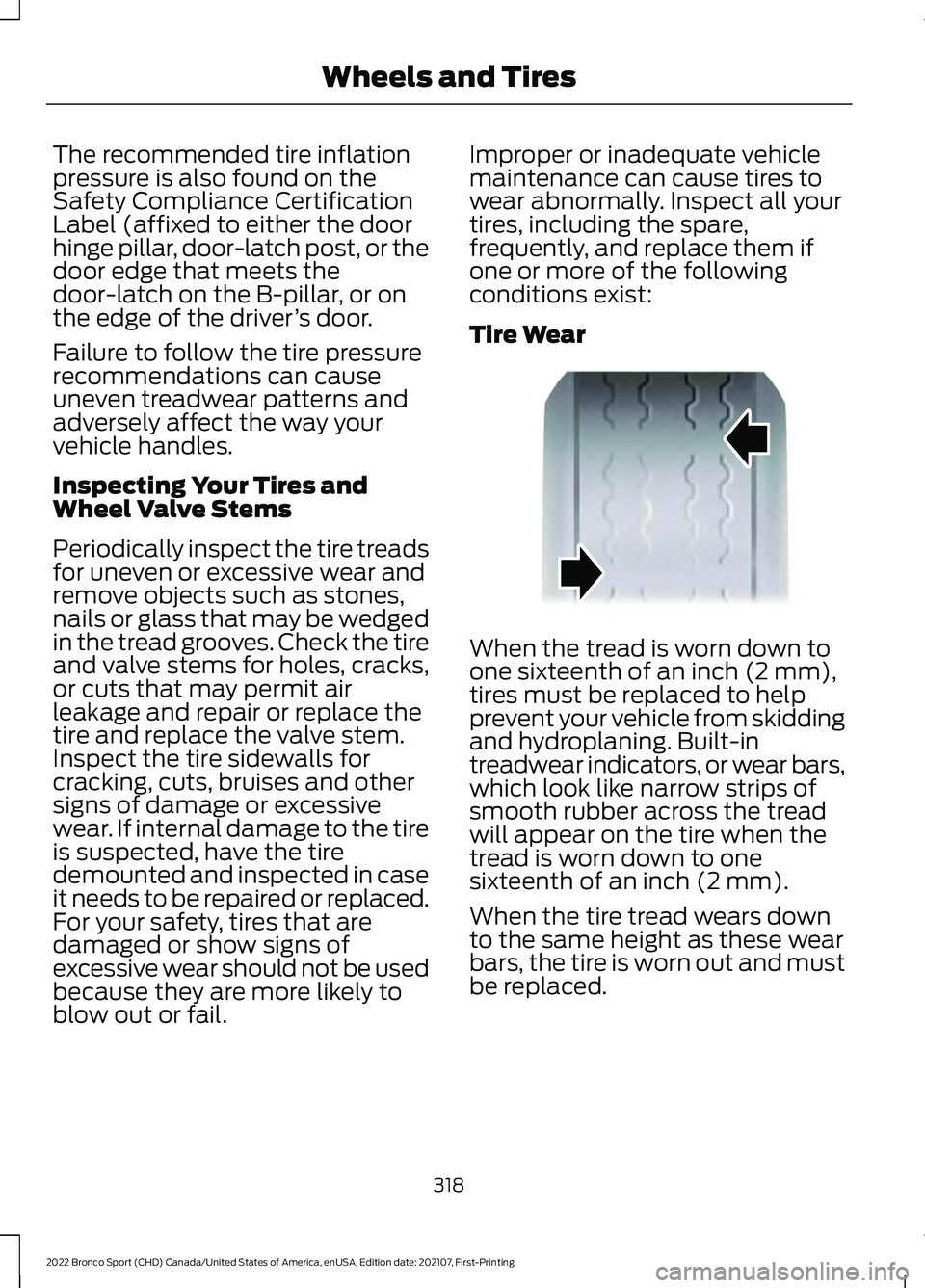
The recommended tire inflation
pressure is also found on the
Safety Compliance Certification
Label (affixed to either the door
hinge pillar, door-latch post, or the
door edge that meets the
door-latch on the B-pillar, or on
the edge of the driver
’s door.
Failure to follow the tire pressure
recommendations can cause
uneven treadwear patterns and
adversely affect the way your
vehicle handles.
Inspecting Your Tires and
Wheel Valve Stems
Periodically inspect the tire treads
for uneven or excessive wear and
remove objects such as stones,
nails or glass that may be wedged
in the tread grooves. Check the tire
and valve stems for holes, cracks,
or cuts that may permit air
leakage and repair or replace the
tire and replace the valve stem.
Inspect the tire sidewalls for
cracking, cuts, bruises and other
signs of damage or excessive
wear. If internal damage to the tire
is suspected, have the tire
demounted and inspected in case
it needs to be repaired or replaced.
For your safety, tires that are
damaged or show signs of
excessive wear should not be used
because they are more likely to
blow out or fail. Improper or inadequate vehicle
maintenance can cause tires to
wear abnormally. Inspect all your
tires, including the spare,
frequently, and replace them if
one or more of the following
conditions exist:
Tire Wear
When the tread is worn down to
one sixteenth of an inch (2 mm),
tires must be replaced to help
prevent your vehicle from skidding
and hydroplaning. Built-in
treadwear indicators, or wear bars,
which look like narrow strips of
smooth rubber across the tread
will appear on the tire when the
tread is worn down to one
sixteenth of an inch (2 mm).
When the tire tread wears down
to the same height as these wear
bars, the tire is worn out and must
be replaced.
318
2022 Bronco Sport (CHD) Canada/United States of America, enUSA, Edition date: 202107, First-Printing Wheels and TiresE142546
Page 322 of 494
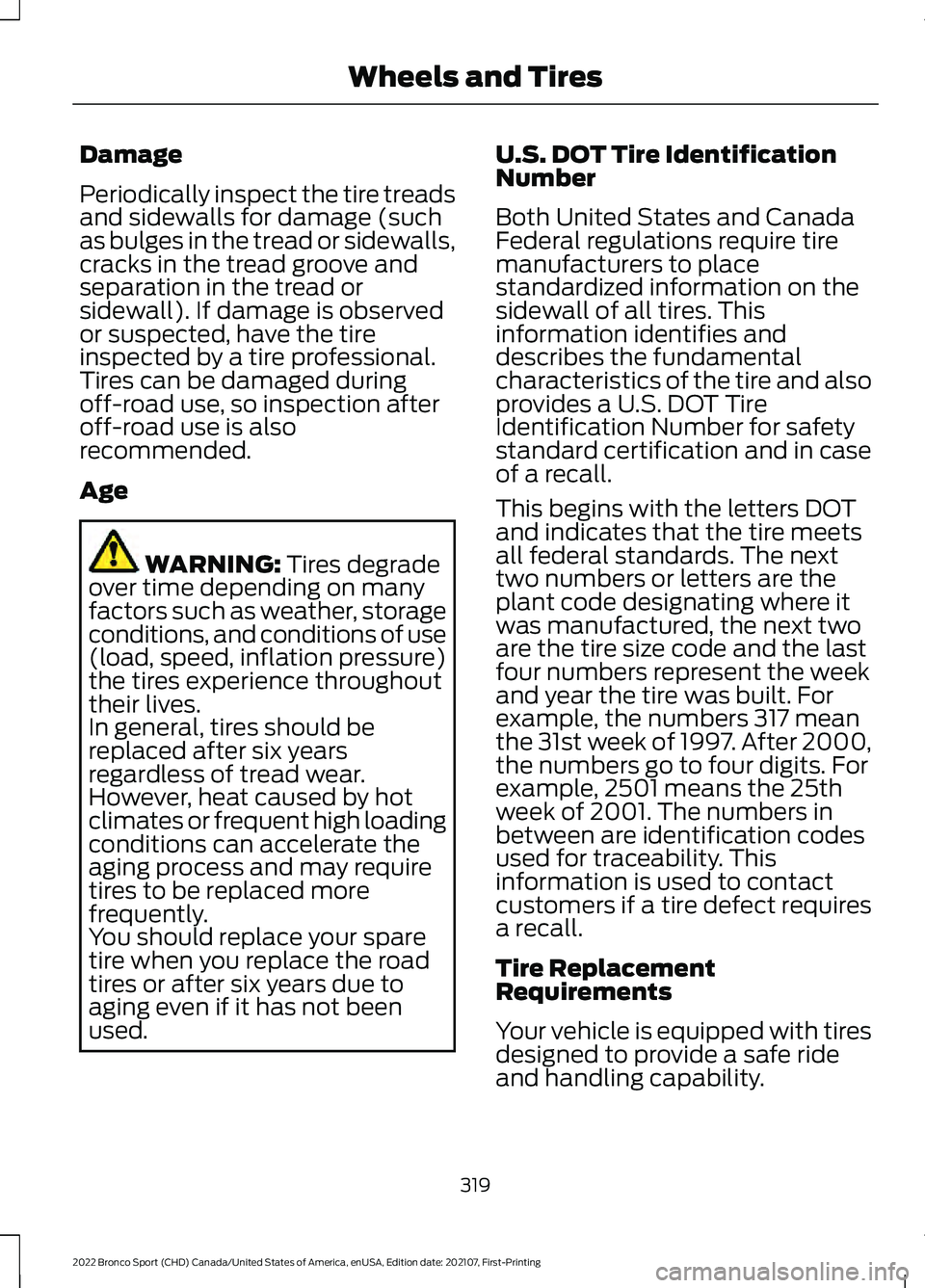
Damage
Periodically inspect the tire treads
and sidewalls for damage (such
as bulges in the tread or sidewalls,
cracks in the tread groove and
separation in the tread or
sidewall). If damage is observed
or suspected, have the tire
inspected by a tire professional.
Tires can be damaged during
off-road use, so inspection after
off-road use is also
recommended.
Age
WARNING: Tires degrade
over time depending on many
factors such as weather, storage
conditions, and conditions of use
(load, speed, inflation pressure)
the tires experience throughout
their lives.
In general, tires should be
replaced after six years
regardless of tread wear.
However, heat caused by hot
climates or frequent high loading
conditions can accelerate the
aging process and may require
tires to be replaced more
frequently.
You should replace your spare
tire when you replace the road
tires or after six years due to
aging even if it has not been
used. U.S. DOT Tire Identification
Number
Both United States and Canada
Federal regulations require tire
manufacturers to place
standardized information on the
sidewall of all tires. This
information identifies and
describes the fundamental
characteristics of the tire and also
provides a U.S. DOT Tire
Identification Number for safety
standard certification and in case
of a recall.
This begins with the letters DOT
and indicates that the tire meets
all federal standards. The next
two numbers or letters are the
plant code designating where it
was manufactured, the next two
are the tire size code and the last
four numbers represent the week
and year the tire was built. For
example, the numbers 317 mean
the 31st week of 1997. After 2000,
the numbers go to four digits. For
example, 2501 means the 25th
week of 2001. The numbers in
between are identification codes
used for traceability. This
information is used to contact
customers if a tire defect requires
a recall.
Tire Replacement
Requirements
Your vehicle is equipped with tires
designed to provide a safe ride
and handling capability.
319
2022 Bronco Sport (CHD) Canada/United States of America, enUSA, Edition date: 202107, First-Printing Wheels and Tires
Page 325 of 494
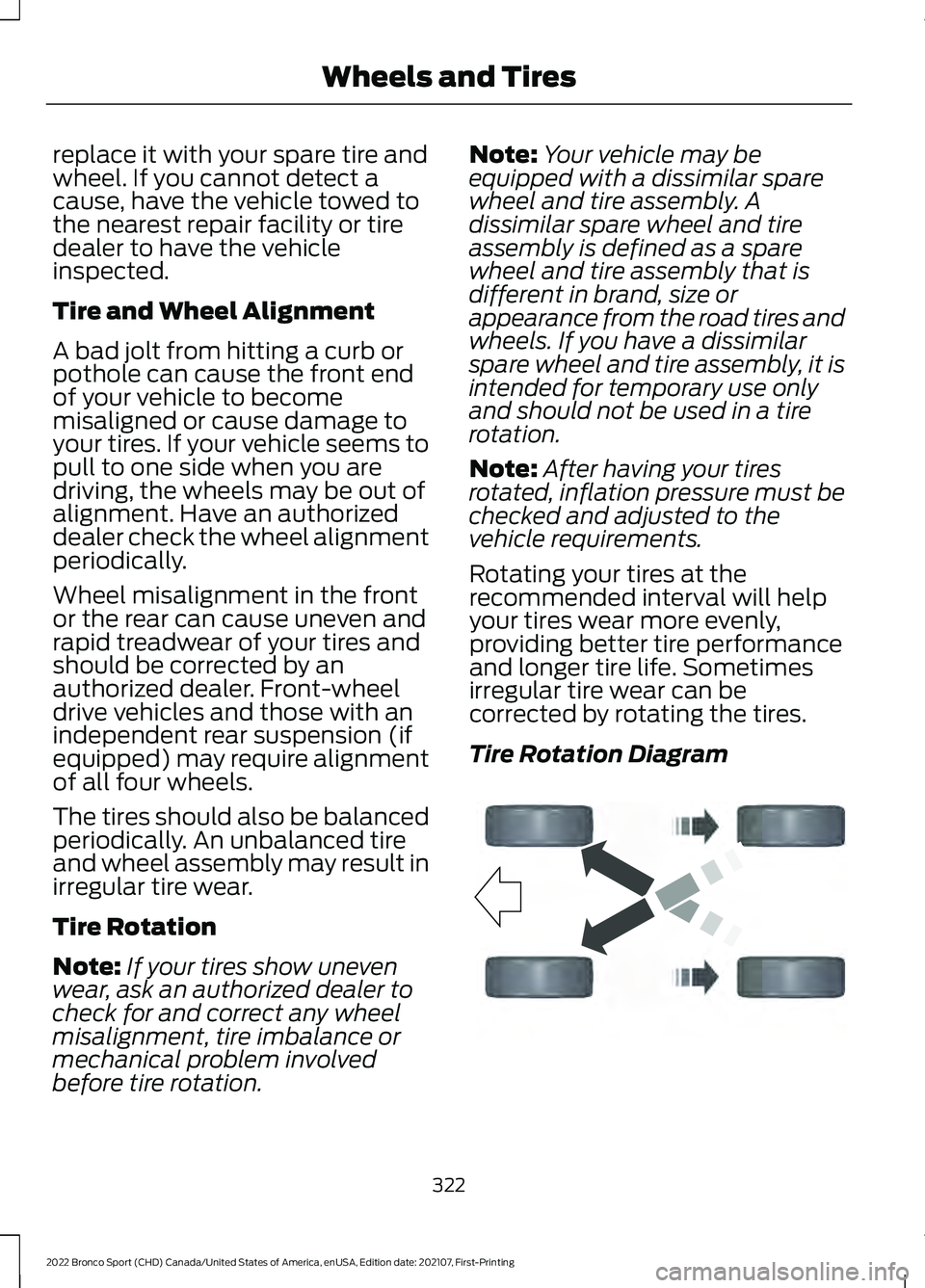
replace it with your spare tire and
wheel. If you cannot detect a
cause, have the vehicle towed to
the nearest repair facility or tire
dealer to have the vehicle
inspected.
Tire and Wheel Alignment
A bad jolt from hitting a curb or
pothole can cause the front end
of your vehicle to become
misaligned or cause damage to
your tires. If your vehicle seems to
pull to one side when you are
driving, the wheels may be out of
alignment. Have an authorized
dealer check the wheel alignment
periodically.
Wheel misalignment in the front
or the rear can cause uneven and
rapid treadwear of your tires and
should be corrected by an
authorized dealer. Front-wheel
drive vehicles and those with an
independent rear suspension (if
equipped) may require alignment
of all four wheels.
The tires should also be balanced
periodically. An unbalanced tire
and wheel assembly may result in
irregular tire wear.
Tire Rotation
Note:
If your tires show uneven
wear, ask an authorized dealer to
check for and correct any wheel
misalignment, tire imbalance or
mechanical problem involved
before tire rotation. Note:
Your vehicle may be
equipped with a dissimilar spare
wheel and tire assembly. A
dissimilar spare wheel and tire
assembly is defined as a spare
wheel and tire assembly that is
different in brand, size or
appearance from the road tires and
wheels. If you have a dissimilar
spare wheel and tire assembly, it is
intended for temporary use only
and should not be used in a tire
rotation.
Note: After having your tires
rotated, inflation pressure must be
checked and adjusted to the
vehicle requirements.
Rotating your tires at the
recommended interval will help
your tires wear more evenly,
providing better tire performance
and longer tire life. Sometimes
irregular tire wear can be
corrected by rotating the tires.
Tire Rotation Diagram 322
2022 Bronco Sport (CHD) Canada/United States of America, enUSA, Edition date: 202107, First-Printing Wheels and TiresE142547
Page 327 of 494
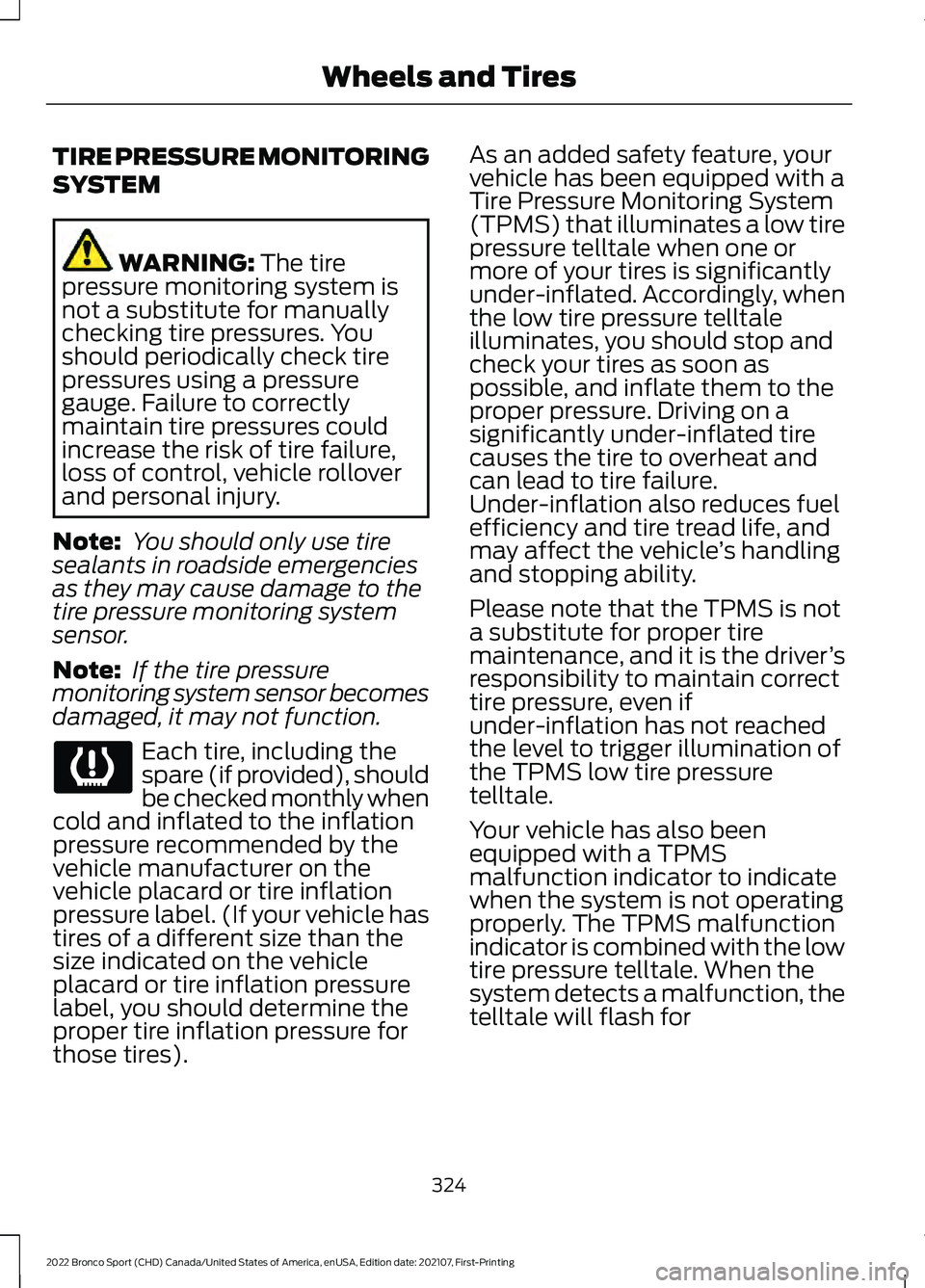
TIRE PRESSURE MONITORING
SYSTEM
WARNING: The tire
pressure monitoring system is
not a substitute for manually
checking tire pressures. You
should periodically check tire
pressures using a pressure
gauge. Failure to correctly
maintain tire pressures could
increase the risk of tire failure,
loss of control, vehicle rollover
and personal injury.
Note: You should only use tire
sealants in roadside emergencies
as they may cause damage to the
tire pressure monitoring system
sensor.
Note: If the tire pressure
monitoring system sensor becomes
damaged, it may not function. Each tire, including the
spare (if provided), should
be checked monthly when
cold and inflated to the inflation
pressure recommended by the
vehicle manufacturer on the
vehicle placard or tire inflation
pressure label. (If your vehicle has
tires of a different size than the
size indicated on the vehicle
placard or tire inflation pressure
label, you should determine the
proper tire inflation pressure for
those tires). As an added safety feature, your
vehicle has been equipped with a
Tire Pressure Monitoring System
(TPMS) that illuminates a low tire
pressure telltale when one or
more of your tires is significantly
under-inflated. Accordingly, when
the low tire pressure telltale
illuminates, you should stop and
check your tires as soon as
possible, and inflate them to the
proper pressure. Driving on a
significantly under-inflated tire
causes the tire to overheat and
can lead to tire failure.
Under-inflation also reduces fuel
efficiency and tire tread life, and
may affect the vehicle
’s handling
and stopping ability.
Please note that the TPMS is not
a substitute for proper tire
maintenance, and it is the driver ’s
responsibility to maintain correct
tire pressure, even if
under-inflation has not reached
the level to trigger illumination of
the TPMS low tire pressure
telltale.
Your vehicle has also been
equipped with a TPMS
malfunction indicator to indicate
when the system is not operating
properly. The TPMS malfunction
indicator is combined with the low
tire pressure telltale. When the
system detects a malfunction, the
telltale will flash for
324
2022 Bronco Sport (CHD) Canada/United States of America, enUSA, Edition date: 202107, First-Printing Wheels and Tires
Page 331 of 494
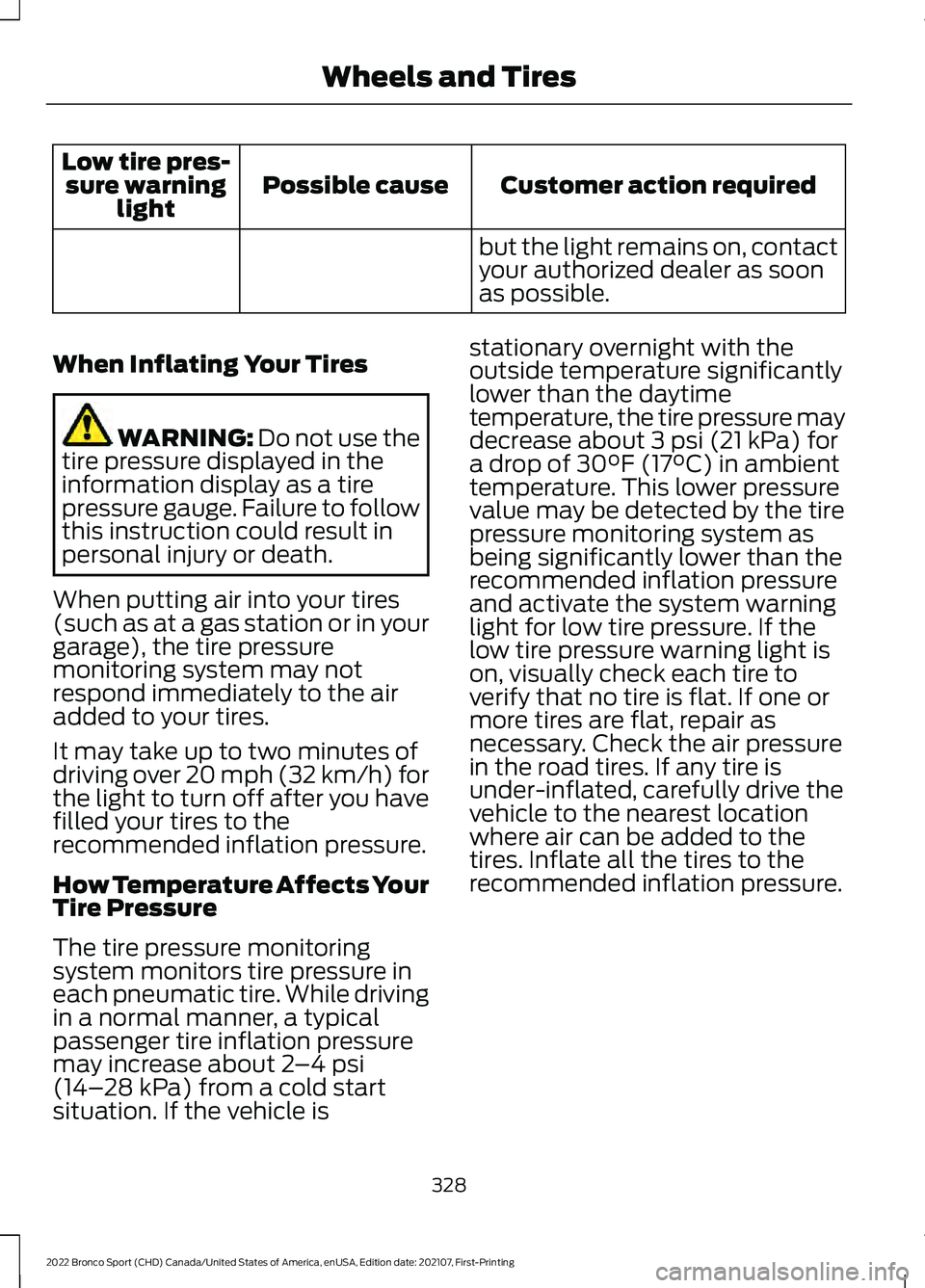
Customer action required
Possible cause
Low tire pres-
sure warning light
but the light remains on, contact
your authorized dealer as soon
as possible.
When Inflating Your Tires WARNING: Do not use the
tire pressure displayed in the
information display as a tire
pressure gauge. Failure to follow
this instruction could result in
personal injury or death.
When putting air into your tires
(such as at a gas station or in your
garage), the tire pressure
monitoring system may not
respond immediately to the air
added to your tires.
It may take up to two minutes of
driving over
20 mph (32 km/h) for
the light to turn off after you have
filled your tires to the
recommended inflation pressure.
How Temperature Affects Your
Tire Pressure
The tire pressure monitoring
system monitors tire pressure in
each pneumatic tire. While driving
in a normal manner, a typical
passenger tire inflation pressure
may increase about
2 –4 psi
(14– 28 kPa) from a cold start
situation. If the vehicle is stationary overnight with the
outside temperature significantly
lower than the daytime
temperature, the tire pressure may
decrease about
3 psi (21 kPa) for
a drop of 30°F (17°C) in ambient
temperature. This lower pressure
value may be detected by the tire
pressure monitoring system as
being significantly lower than the
recommended inflation pressure
and activate the system warning
light for low tire pressure. If the
low tire pressure warning light is
on, visually check each tire to
verify that no tire is flat. If one or
more tires are flat, repair as
necessary. Check the air pressure
in the road tires. If any tire is
under-inflated, carefully drive the
vehicle to the nearest location
where air can be added to the
tires. Inflate all the tires to the
recommended inflation pressure.
328
2022 Bronco Sport (CHD) Canada/United States of America, enUSA, Edition date: 202107, First-Printing Wheels and Tires